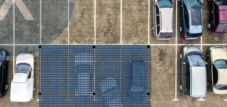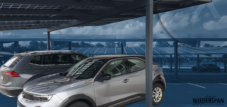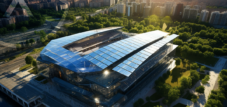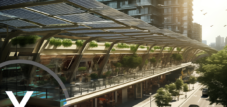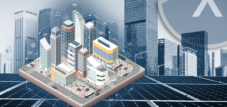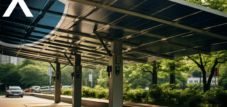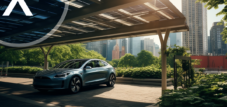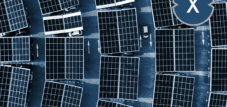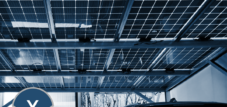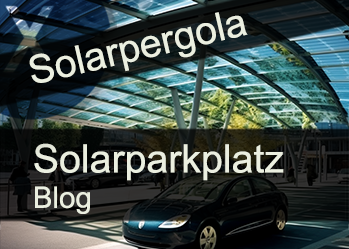Urban planning retrofit - the city of the future from gray to green - solar parking spaces and solar pergolas as a weapon against sealed areas and heat islands
Published on: March 14, 2024 / Update from: March 14, 2024 - Author: Konrad Wolfenstein

Green oases and solar magic: Creating new living spaces in the city - against sealed surfaces and heat islands - Image: Xpert.Digital
🌆➡️🌿 Urbanization and urban heat islands: The path to a greener and more sustainable future
📈 In recent decades, urbanization has increased significantly worldwide. This trend is leading to more and more areas being sealed to meet the need for housing, infrastructure and industry. A direct consequence of this development is the phenomenon of urban heat islands, i.e. areas in which temperatures are significantly higher than in their rural surroundings. One way to counter this phenomenon and at the same time promote the transition to renewable energies is through integrative urban planning, which places a particular focus on retrofitting, i.e. the retrofitting and upgrading of existing urban structures. Two approaches in particular deserve special attention: the conversion of sealed areas into solar parking spaces and solar pergolas as well as the expansion of green spaces with the help of partially transparent solar modules.
🌞 Solar parking spaces and solar pergolas
Solar parking lots and solar pergolas can serve a dual function in urban spaces. Firstly, they offer protection from direct sunlight for the vehicles parked underneath, which is particularly advantageous on hot summer days. Secondly, the installed solar modules generate green electricity that can be used locally or fed into the public grid. These structural measures not only contribute to reducing urban heat islands by absorbing direct solar radiation and converting it into energy, but they also promote local energy autonomy and the use of renewable energy sources. In addition, intelligent design and integration of electric vehicle charging stations can create synergies that support and advance sustainable mobility in cities.
🌱 Green areas and partially transparent solar modules
Another exciting approach is the expansion of green spaces using partially transparent solar modules. These innovative solar panels not only allow the generation of electricity, but also allow enough sunlight through to allow plants to grow underneath. Combining green oases with solar energy production in urban areas offers numerous benefits. On the one hand, vegetation helps improve air quality by absorbing CO2 and producing oxygen. On the other hand, green spaces offer space for social interaction and relaxation, which is often neglected in densely built-up urban areas. In addition, green spaces help regulate the urban microclimate by providing cooling and thus mitigating the phenomenon of urban heat islands.
🛠️ Challenges and opportunities
The implementation of these two approaches requires well-thought-out urban planning that takes existing structures into account and combines them with new, innovative solutions. A particular challenge lies in integrating these measures into the historical context of many cities. In order to ensure the acceptance and success of such projects, it is essential to involve the local population from the outset and to promote a participatory planning process.
💸 Financing and long-term benefits
Financing such initiatives represents another challenge, but can be overcome by combining various funding sources, public-private partnerships and innovative financing models such as crowdfunding platforms. Experience also shows that investments in sustainable urban development pay off both economically and socially in the long term by improving the quality of life, strengthening the local economy and contributing to climate protection.
🔑 Transformation of existing urban spaces through retrofitting as the key
In conclusion, it can be said that the transformation of existing urban spaces through retrofitting within urban planning not only represents a way to meet the challenges of urbanization and climate change, but also offers an opportunity to make cities more livable, sustainable and future-proof. By upgrading sealed areas with solar parking spaces and solar pergolas and promoting the expansion of green spaces with the help of partially transparent solar modules, we can make an important contribution to reducing urban heat islands and at the same time promote the transition to a sustainable energy supply. The key to this success lies in creative and integrative planning that makes good use of existing resources and technologies and puts people at the center of urban development.
📣 Similar topics
- 🌆 Sustainable urban development: solar parking spaces and pergolas as key
- 🌞 Use of solar pergolas to combat the urban heat island phenomenon
- 🏞 Green oases in the city: The added value of partially transparent solar modules
- 🚗 Charging stations and green electricity: The future of urban mobility
- ☀️ The transformation of sealed surfaces into energy sources
- 🌿 Combination of vegetation and solar energy in urban areas
- 🏛 Retrofit urban planning: tradition meets modern energy concepts
- 🌐 Participatory urban planning: involving the community in renewal
- 💡 Innovative financing models for sustainable city projects
- 🔄 From the sealed to the living city: A vision of sustainability
#️⃣ Hashtags: #SustainableCityDevelopment #SolarEnergyInCities #GreenPlantsExpansion #UrbanMobility #RetrofitCityPlanning
📌 Other suitable topics
🎯🎯🎯 Benefit from Xpert.Digital's extensive, fivefold expertise in a comprehensive service package | R&D, XR, PR & SEM

AI & XR 3D Rendering Machine: Fivefold expertise from Xpert.Digital in a comprehensive service package, R&D XR, PR & SEM - Image: Xpert.Digital
Xpert.Digital has in-depth knowledge of various industries. This allows us to develop tailor-made strategies that are tailored precisely to the requirements and challenges of your specific market segment. By continually analyzing market trends and following industry developments, we can act with foresight and offer innovative solutions. Through the combination of experience and knowledge, we generate added value and give our customers a decisive competitive advantage.
More about it here:
🌱🔋 Energy generation and environmental education: The dual function of urban green spaces
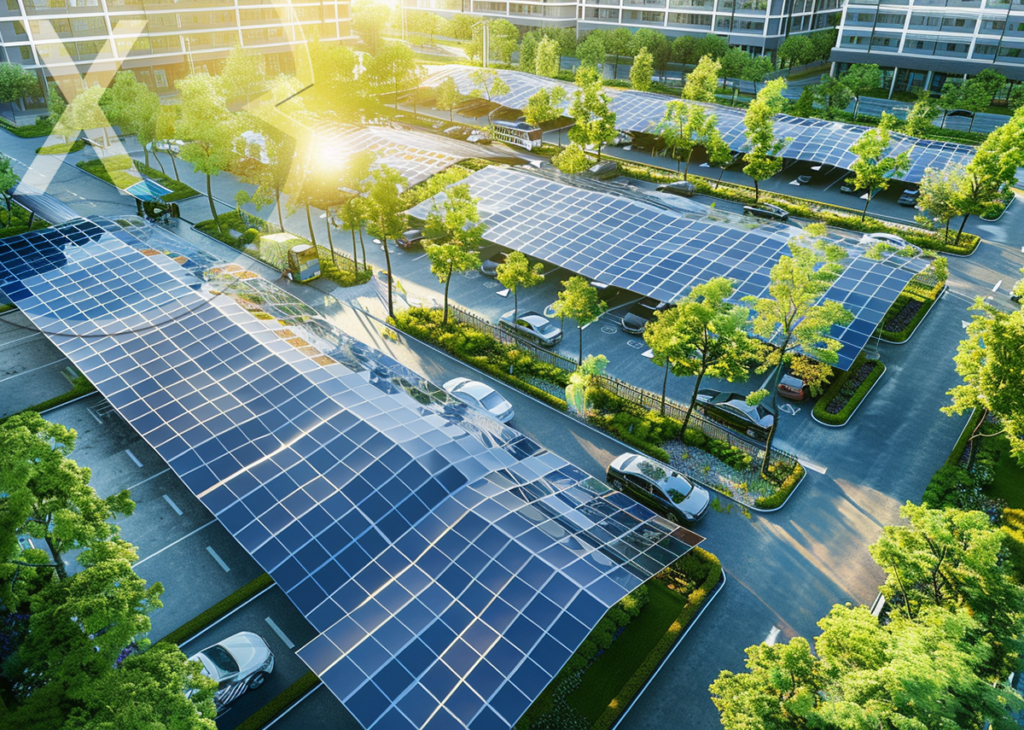
Environmental education in the urban jungle: The versatile use of green spaces and solar systems - Image: Xpert.Digital
🌆🌿 Urban renewal and sustainability through retrofitting projects
However, the successful implementation of such retrofitting projects in urban planning requires that several key aspects be taken into account. One of the most important aspects is the holistic view of the urban infrastructure. It is not enough to look at individual areas in isolation and retrofit them. Rather, networked planning must take place that harmonizes the different needs and functions of urban spaces. For example, solar parking spaces can not only be used to generate energy, but also act as hubs for urban electromobility. Likewise, green spaces equipped with partially transparent solar modules can, in addition to their recreational function, also serve educational purposes by informing the population about sustainable technologies and climate protection measures.
🛤 Holistic view of urban infrastructure
Another important point is technological innovation. The development and integration of new technologies, such as more powerful and aesthetically pleasing solar modules, intelligent energy management systems or sustainable building materials, is crucial for the success of retrofitting projects. These innovations not only offer efficient solutions to existing problems, but also help make urban infrastructure sustainable.
🌱 Technological innovations and aesthetic approaches
In addition, the social component plays a crucial role in the planning and implementation of sustainable urban development projects. The involvement of citizens, the transparency of the planning process and the creation of added value for the local community are essential to ensure acceptance and participation. A city that integrates its residents into the process of urban development not only promotes collective awareness of sustainability and climate protection, but also strengthens social cohesion.
🤝 Social integration and participation
Another aspect that cannot be ignored in sustainable urban planning is the resilience of urban systems. Given climate change and its impacts, it is essential to design urban spaces to be resilient to extreme weather events, rising temperatures and other challenges. This requires flexible and adaptive planning concepts that include both preventive measures and strategies for rapid recovery from events.
🌪 Resilience to the challenges of climate change
The transformation and upgrading of urban spaces through retrofitting in urban planning is a complex process that takes a number of factors into account. It's not just about solving existing problems such as urban heat islands and promoting the transition to renewable energy, but also about creating cities that are livable, inclusive, resilient and sustainable. Realizing this vision requires innovative approaches, interdisciplinary collaboration and the commitment of everyone involved - from the city administration and local communities to private companies and science. At a time when sustainability and climate protection are among the most pressing tasks in our society, retrofitting in urban planning offers a promising opportunity to address these challenges and set the course for the sustainable development of our cities.
📣 Similar topics
- 🌆 Connected future: The importance of holistic urban planning in the retrofitting process
- 🚗⚡ Electromobility and solar parking spaces: key elements for urban sustainability
- 🌿📚 Green spaces as places of education: teaching sustainable technologies
- 💡🌱 Technological innovations: paving the way for sustainable cities
- 🤝💬 Social participation: The core of successful urban development projects
- 🛠️🏙️ Retrofitting: A strategy against urban heat islands and for renewable energies
- 🏛️🌐 Interdisciplinary collaboration: The key to integrative cities
- 🏘️🌀 Resilience of urban spaces: Adaptation to climate change
- 🌎🔧 Mastering the challenges of climate protection through innovative urban planning
- 🏢🌿 Creating Livable Cities: The Role of Sustainability and Resilience
#️⃣ Hashtags: #SustainableCityDevelopment #Retrofitting #UrbanResilience #Electromobility #GreenInfrastructure
📌 Other suitable topics
🌱🏙 Sustainable visions for the city of the future
📘 Paradigm shift in urban planning
In order to make the vision of a sustainably retrofitted city a reality, a paradigm shift in urban planning and development is required. This affects not only the technical and infrastructural aspects, but also the cultural, social and political dimensions of urban life. A key aspect of this change is promoting a culture of sustainability and resilience. This includes raising awareness and educating the citizenry about the benefits and needs of environmentally friendly adaptations, as well as creating incentives for sustainable behavior at individual and collective levels.
🌐 Smart city concepts support the transformation
A concrete approach to support this transformation is the development and implementation of smart city concepts that use digital technologies to make urban systems and services more efficient, sustainable and citizen-friendly. For example, smart grids and energy management systems can help make optimal use of the energy generated from solar parking spaces and solar pergolas. At the same time, apps and digital platforms that provide real-time information about traffic flows, air quality and available green spaces encourage more conscious and environmentally friendly behavior among city residents.
🤝 Collaboration between different actors
Another important pillar for the success of sustainable urban development projects is cooperation between different actors. Cities can enter into collaborations with companies, research institutions and non-governmental organizations to gain access to the latest technological developments and expertise. Such partnerships can also open up new sources of financing needed to implement ambitious projects. In addition, collaboration with civil society enables measures to be better aligned with the needs and preferences of the local community, which increases acceptance and participation in the transformation process.
🔄 Adaptive and flexible planning approaches
To ensure the long-term sustainability and effectiveness of retrofitting projects, it is also crucial that cities adopt adaptive and flexible planning approaches. This means that plans and projects must be regularly evaluated and adapted to changing conditions and findings. Such iterative planning allows learning from experience and continuously improving and optimizing innovative solutions.
🌍 Comprehensive strategy against climate change
Finally, it is crucial that urban development measures are embedded in a comprehensive strategy that addresses both mitigating climate change and adapting to its already noticeable impacts. This includes measures to reduce greenhouse gas emissions, promote biodiversity, protect against extreme weather events, and ensure social justice and access to basic services for all city residents.
Overall, the realization of sustainable, future-proof cities through retrofitting requires a multidisciplinary, holistic approach that combines technological innovations with socio-economic and cultural change processes. By actively shaping this transformation, cities can not only improve their resilience and quality of life, but also take a leading role in the global push for a more sustainable, fair and resilient future.
📣 Similar topics
- 🏙️ Realignment of cities: On the way to more sustainability and resilience
- 🌱 Cultural change in the city: Education for sustainability
- 📲 Smart City Strategies: The digital revolution of urban space
- 💡 Integration of Smart Grids: Future of urban energy supply
- 🤝 The power of cooperation: Together for sustainable cities
- 🔄 Flexibility in urban planning: Learn and adapt for better results
- 🌍 Climate change in the city: Strategies for mitigation and adaptation
- 🚀 Technology meets sustainability: new paths to urban well-being
- 🌳 Biodiversity as a pillar of urban sustainability
- 🏘️ Social Justice: A Foundation for Sustainable Cities
#️⃣ Hashtags: #SustainableCityDevelopment #SmartCity #CityPlanning #ClimateResilience #SocialJustice
We are there for you - advice - planning - implementation - project management
☑️ From simple solar carports to large parking spaces
☑️ Your individual photovoltaic parking space advice with Xpert.Solar
Xpert.Solar is your ideal partner for the planning, consulting and construction implementation of ground-mounted photovoltaic systems and agricultural photovoltaic projects due to our many years of experience and expertise in the solar energy industry. Xpert.Solar has an experienced team of professionals that offers tailored solutions to farmers and investors. From location analysis to financial and legal advice to technical implementation and monitoring, Xpert.Solar supports its customers professionally and reliably to ensure successful and sustainable implementation.
I would be happy to serve as your personal advisor.
You can contact me by filling out the contact form below or simply call me on +49 89 89 674 804 (Munich) .
I'm looking forward to our joint project.
Xpert.Digital - Konrad Wolfenstein
Xpert.Digital is a hub for industry with a focus on digitalization, mechanical engineering, logistics/intralogistics and photovoltaics.
With our 360° business development solution, we support well-known companies from new business to after sales.
Market intelligence, smarketing, marketing automation, content development, PR, mail campaigns, personalized social media and lead nurturing are part of our digital tools.
You can find out more at: www.xpert.digital - www.xpert.solar - www.xpert.plus
Plan your solar system for the most common applications conveniently online with our solar system planner!
With our user-friendly solar system planner you can plan your individual solar system online. Whether you need a solar system for your home, your business or for agricultural purposes, our planner offers you the opportunity to take your specific requirements into account and develop a tailor-made solution.
The planning process is simple and intuitive. You simply enter relevant information. Our planner takes this information into account and creates a tailor-made solar system that meets your needs. You can try out different options and configurations to find the optimal solar system for your application.
Additionally, you can save your plan to review later or share with others. Our customer service team is also available to answer your questions and provide support to ensure your solar system is optimally planned.
Use our solar system planner to plan your individual solar system for the most common applications and advance the transition to clean energy. Start now and take an important step towards sustainability and energy independence!

The solar system planner for the most common applications: Plan the solar system online here - Image: Xpert.Digital
More about it here:



